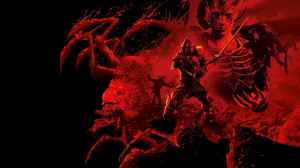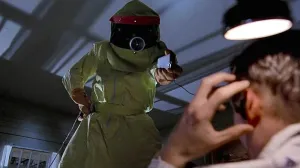Today in DC’s Generations Shattered #1, fans got a look at a new version of Booster Gold — the second such new take on the character in a fairly short amount of time. It really drives home something that’s kind of interesting about Booster as a character: since he is a time-traveler, he finds himself forever bouncing through time…and that has led to what might be more canonical versions of Booster Gold existing in DC’s main timeline than any other single character in the DC Universe. That’s because the time-travel aspects just roll from one version to the next, meaning that while most DC characters will get rebooted following a major change to the cosmic status quo, Booster usually doesn’t.
Videos by ComicBook.com
For those who don’t know, Booster Gold was originally Michael Jon Carter, a college athlete in the 25th Century, who was caught gambling and kicked off his team. His mother’s health problems, which had driven him to gamble in the first place, got the best of her, and she passed away, leaving Michael alienated from his twin sister Michelle (their father, Jon Carter, had left when they were very young and was not in the picture).
After getting a job as a nightwatchman at a museum, Michael happened upon an exhibit celebrating the legacy of 20th century superheroes. Tired of his dead-end life, he hatched a plan to steal some gear and weapons that, being from the 25th Century, would seem magical to the people of the 20th, and travel back in time to join them as a superhero.
That origin story has remained more or less intact, although the nature of DC’s rolling timeline means that at some point in the story, it was no longer Ronald Reagan whose life Michael saved during his first outing as Booster Gold, but another (likely fictional) President.
Not long after making a name for himself, Booster joined the Justice League International and befriended Ted Kord/Blue Beetle, establishing arguably the most important relationship of his life in the past. Eventually, he went on to be a Time Master…but at that point we’re getting dangerously close to where things start to splinter and diverge for the DC Universe.
Here’s the various versions of Booster Gold that you might find floating aroudn the DC Universe right now — and it wouldn’t even create a continuity error! Let us know in the comments if we missed one.
’80s Booster

The original Booster traveled back to the 1980s and saved Ronald Reagan from an assassination attempt, grabbing headlines and making an immediate name for himself.
This version of Booster, who appeared in Booster Gold volume 1 by Dan Jurgens, is visually distinct from his successors in one notable way: there’s a pentagonal gold shape in the center of the blue star on his chest, made up by essentially drawing a five-point star freehand without lifting the pencil.
That costume essentially disappeared from the comics almost immediately after the first volume of Booster’s solo book was cancelled.
This version of Booster was actively running a multinational corporation that focused on selling Booster as a brand, and using his heroics to sell his image, making him feel like a slick con man — although he would always stop short of actually being a con man. He was a real hero — just one who saw the potential to make a buck in heroics.
We would not necessarily have thought he was a distinct entity from the next version of Booster we will discuss, except that in Generations: Shattered #1, it is clear that this Booster is explicitly back, ’80s backstory and all.
The Booster of 52

Between the late ’80s and the events of 52, the weekly crossover event in 2007, Booster Gold more or less had his original origin, but with a rolling timeline that allowed for him to always remain just a few years older than when he first arrived, rather than having 20+ years in the business.
During this time, Booster was part of the Justice league, and part of Extreme Justice. During that time, he and Blue Beetle became friends and got a reputation as the Laurel and Hardy of superheroes, and that branded them as goofballs that the audience (and sometimes other heroes) didn’t take seriously.
He eventually joined up with Rip Hunter and became a Time Master as part of 52. During 52, Booster was using his knowledge of future events (catalogued exhaustively inside of Skeets, his android pal from his security guard days) to promote his brand and career by making spectacular saves at times when he knew things were going to go wrong. Hunter pulled him out of that and told him that time was broken, and that he and Skeets were key to fixing it and saving the universe. That aspect of his personality has been picked up in Batman: The Brave and the Bold and Justice League Action, as well as a live-action appearance on Smallville, but it’s worth pointing out that the original Booster traveled back through the period of the Great Disaster, so his knowledge of our time was sketchy and incomplete, meaning that the “Volume 1” Booster rarely did this.
The Time Master role carried over to Booster Gold vol. 2, in which Geoff Johns, Jeff Katz, and Dan Jurgens focused on the time-travel element (something that had not generally been a big part of Booster’s everyday existence as a hero before), making him a secret time cop whose apparent greed and incompetence part of a cover designed to keep time-traveling villains from looking too long at him, or worse, traveling to the future to kill him before he could become a hero.
Dead Booster

At a key point in 52, Booster finds himself feuding with an upstart superhero called Supernova, who keeps beating him to the punch of saving people and stealing his thunder. Booster, in a moment of pique, ends up accidentally sacrificing himself while trying to outdo his foe.
…Except not really. It later turned out that since Skeets had been secretly corrupted by Mr. Mind, and was one of the series’ villains, Booster knew he needed a way to take himself off the board in a way that Skeets would not find suspicious. A slightly-older version of Booster became Supernova, and fake-feuded with himself until his “death.”
The body, though, was real: it was stolen from a future point in time when Booster really was dead, and presumably replaced there after the ruse was revealed.
Or, y’know — maybe not. It’s entirely possible that Booster Gold’s charred, skeletal remains are still kicking around 21st Century Metropolis.
Rip’s Father, Booster Gold

During Booster Gold vol. 2, audiences learned that Rip Hunter, the Time Master and inventor of the Time Sphere who had been tutoring Booster since his earliest days, was in fact Booster’s son, who had traveled back to the past after becoming an adult in order to operate secretly in a way that would help shape the future of the Time Masters.
The current-day Booster has never become aware of this reality in-story, but audiences have — because an older (probably mid-50s or so) version of Booster appeared occasionally in Booster Gold vol. 2, talking with Rip and helping to guide the story.
The New 52 Booster

When Flashpoint happened, Booster was (along with Barry Allen) one of the only two DC heroes who lived through the experience and remembered elements of it later. Having traveled to the Flashpoint universe to try and help fix time, Booster came back to Vanishing Point (a place outside of time that houses the Time Masters and Linear Men, two teams of time-traveling heroes) at the end and declared that he would have to replace his costume, which had been badly damaged in a fight with Doomsday.
The next time Booster popped up — in Justice League International #1 — he was indeed wearing a new costume, but the degree to which he remembered anything pre-Flashpoint was unclear. There were indications that he was secretly a Time Master and working with the JLI as part of a cover operation, and he would periodically talk to Skeets, who never appeared on camera but only talked to Booster through his costume, seemingly while stationed at Vanishing Point.
During Justice League International Annual #1, Booster met a previously-unseen future version of himself, who warned him that something was wrong with time — but New 52 Booster didn’t have an opportunity to fix it, as he seemingly blinked out of existence when Superman and Wonder Woman kissed for the first time.
ARGUS Booster

The Booster Gold who first appeared in Justice League International Annual #1 had a more utility-belt style to his costume, and an ARGUS patch, suggesting that at some point he had started working with Steve Trevor and the US government.
We got this version’s backstory in Futures End: Booster Gold #1, which revealed that he was the pre-New 52 Booster, and had been tossed through time, appearing randomly at significant events, for quite a while. Eventually he encountered Michelle (who at one point had adopted her own superhero alter ego, Goldstar), and the two of them were captured by mysterious forces. They found themselves face to face with the New 52 Booster, who had apparently not been wiped from existence after all.
And that was it for a while…
Booster Gold 3001

At one point, when the Legion of Super-Heroes had been out of print for a while but DC still wanted to ine the 31st Century for story, ’80s Justice League scribes Keith Giffen and J.M. DeMatteis were tapped to write Justice League 3000 (and then 3001).
After a couple of arcs with futuristic versions of the traditional Justice League “big seven,” Giffen and DeMatteis started to find ways to bring some of their old favorites back, including a cryogenically-frozen Blue Beetle and Booster Gold. With the disco collar on Booster’s costume and seemingly very limited time-travel capacity, this Booster feels like an extension of his ’80s identity.
Of course, the Giffen/DeMatteis Booster is a bit like the King Booster (albeit for entirely different reasons). He has personality tics and even bits of personal history that don’t track with anything before or after (he was once married to a wealthy widow, for instance, and he and Rip later adopted a young girl whose parents were wiped out during one of Booster’s missions).
It seems fair to assume that this version of Booster is a bit of a chronal anomaly — somebody from “Earth-JLI,” so to speak. Still, he’s canon, and if one were to travel to that part of the future, it’s plausible you’d find him there.
Waverider Booster

…The Convergence event, in which various realities from DC’s past which had been wiped from existence were revisited, the time-travelers of the DC Universe were trapped on Skartaris, home of Travis Morgan the Warlord), where time doesn’t pass. This helped to nullify their powers and make them random and unpredictable.
There, we learned that the ARGUS Booster wasn’t exactly the pre-New 52 Booster that we had thought. Instead it was the version of Booster who was Rip Hunter’s father — a revelation made to the New 52 Booster during the commotion.
The older Booster, dying from an influx of chronal energy after a lifetime of traveling back and forth through time to save the multiverse, found himself fighting to save his son, his sister, his alternate-younger-self, and the DC Universe as a whole before his time ran out. Eventually, he sacrificed himself inside the chronal field that powers Vanishing Point. That sacrifice transformed his body to one of pure chronal energy, remaking him in the image of another time-traveling Jurgens creation — Waverider.
Now virtually all-seeing and all-powerful, Rip’s dad sends everyone around him back to where they belong, and the New 52 Booster becomes the full-time Booster Gold of the DC Universe — albeit with a memory of Convergence that would likely inform some of his future actions.
Of course, that doesn’t much matter, because shortly after this, DC Universe: Rebirth happened, and among the changes made to DC’s publishing line was an alteration to the younger Booster that essentially brought his costume, history, and personality in line with the pre-Flashpoint Booster. It is unclear whether he remembers his older self’s sacrifice, or the fact that Rip is his son.
Generations Shattered also raises some questions about whether the Booster Gold version of Waverider still exists, and whether Booster’s future is set in stone, but we’ll get to that.
Tom King’s Booster

When Booster Gold appeared in Tom King’s Batman run, it seemed like a curious fit. The grounded, character-driven, and street-level take on Batman that King had been writing up to that point would soon be upended by Booster Gold and Flashpoint Batman.
When Booster showed up, he was the Rebirth take — ostensibly the same guy as New 52 Booster, but with his 2007 costume and Time Masters backstory fully intact.
Upon learning that Batman and Catwoman were engaged, Booster felt compelled to set aside his Time Master duties and give Batman what amounted to a mental vacation in an alternate timeline, by temporarily saving the Waynes from being murdered and changing history in a way that made Bruce a happy, wealthy middle-aged man about to marry a beautiful debutante, rather than an obsessed vigilante.
When Bruce learned that Booster was going to fix time, leaving “our” Bruce with this one’s happy memories, he got the jump on Booster and captured him. The next time we saw him, a good deal of time had clearly passed, as Booster appeared emaciated and had a long, bushy beard.
Eventually he did succeed in fixing the timeline and returning to the status quo, and while the time lost to the alternate-reality Wayne Manor would often be written out or swept under the rug as chronal flotsam, here we learned that Booster did indeed experience it all, and it helped inform his need to get therapy in Heroes in Crisis.
King’s take on Booster can more or less be seen as a bit of an outlier. Canonically, there is no doubt these things happened, but it feels like the kind of arc that makes sense only with its own walls. Right around the same time Booster was saving the Waynes to give Bruce a time-vacation, he was fighting to make sure Superman didn’t travel back to see the death of Krypton in Action Comics on the off chance that the Last Son of Krypton somehow messed up his own origin story.
The King story also raises questions about how “solid” time works in the post-Flashpoint DC Universe, because in Volume 2, Booster repeatedly tried to save Barbara Gordon from being paralyzed at the hands of The Joker, but failed because it was impossible to change an event that so much other history flowed from. Certainly it’s hard to argue that the deaths of the Waynes wouldn’t be even more “solid” in that respect. So one could argue that King’s Booster almost feels like an Elseworlds version, except that the sweeping impact of Heroes in Crisis on the DC Universe’s main timeline proves that it did, indeed, happen to the “main” Booster.
Bendis’s Booster

During Legion of Super-Heroes: Millennium #2, Brian Michael Bendis made a minor tweak to Booster’s origin story, that is really only relevant in that we are tracking all of these maneuvers and changes to the timeline, so it might suggest that the post-Rebirth Booster really is a fully different person than the New 52 Booster, and that the events of Rebirth either wiped out or relocated New 52 Booster.
That’s probably over-reaching, though; the simpler answer is that since we never saw an origin story for New 52 Booster, this is it.
It is more or less the same, with Booster working at a museum. Here, though, his decision to travel back and her a hero is more about wanting to make something of himself, and a bit less calculating than it was depicted in Jurgens’s original backstory.
It’s also notable in that the moment he decides he could be a superhero, seems to be inspired by an image of Rip Hunter in his earliest Time Master adventures, before they got so cosmic and superhero-y.
Booster Gold Beyond

During a recent issue of Batman Beyond, audiences got another take on an Older Booster. Once again working with Rip Hunter, this Booster looks markedly older than the one from Volume 2, and in this case, the aging Bruce Wayne from Batman Beyond is also working with him — a continuation of the evolution that Johns, Katz, and Jurgens depicted in Bruce’s relationship to Booster throughout Volume 2.
In that story, we saw Booster send his younger self and Terry McGinnis into the past in a bid to save a child who eventually proved to be Terry’s own father. The incident, written about in Terry’s father’s journal, was apparently predestined, becuase the older Bruce immediately recognized the description of Terry’s costume. Realizing that the suit had not yet been designed in 2020, Bruce reached out to Booster to make it happen.
Since Booster had never shown a previous predisposition toward facial hair (creepy alternate-Earth-prisoner Booster aside), it seems likely that the mustache here was setting up our next and final (for now?) Booster.
Generations Shattered Booster

With fully-gray hair, a beard, and a version of Skeets that has been melted down to be a gauntlet, this take on Booster is clearly the oldest we have seen yet — although he has somehow managed to avoid the ravages of time that once seemingly forced him to become Waverider.
We see a version of Waverider in this issue, too, and he appears to be the pre-Flashpoint version (who died in a previous story and whose corpse was used as a weapon in Time Masters: Vanishing Point, a story set firmly in the Volume 2 timeline).
We see what appears to be the death of this Booster — and thus maybe the final death of Booster Gold? — but it’s prevented yet again, this time by the timely appearance of Waverider, who recruits the older Booster for a mysterious mission. They aren’t seen again, but given that Booster’s much younger self joins a group of Forgotten Heroes at Vanishing Point, and they end up fighting the Linear Men…well, it’s likely that “Booster Gray” is going to be part of a cosmic Plan B in case things don’t work out for the lead team.
You can get most of these stories on DC Universe with a subscription, although Batman Beyond #48 and 49, as well as Generations: Shattered #1, would all have to be purchased through ComiXology or another digital comics storefront.
If we got any of this complicated history wrong, or missed an obvious version we should have talked about, you can bet it will show up soon on Boosterrific.com, so you can take a look over there if you’d like.








